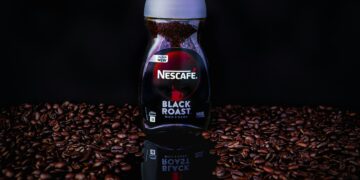Table of Contents
Executive Summary & Introduction to Cold Brew Stability
Direct Answer to the Primary Query
An analysis of brand directives, food safety principles, and chemical stability confirms that STōK Cold Brew products must be refrigerated.
This applies to bottles both before and after they have been opened.
A definitive statement from a STōK brand representative clarifies the company’s official position: “Yes, our brews need to remain refrigerated”.1
This instruction is not merely a suggestion for optimal taste but a critical requirement for maintaining product quality and, most importantly, ensuring consumer safety.
Report Objective and Scope
This report provides a comprehensive scientific rationale for the refrigeration mandate, moving beyond a simple affirmative answer to explore the underlying chemical and microbiological principles.
The analysis will deconstruct the factors that make ready-to-drink (RTD) coffee a perishable product, examining how its stability is influenced by ingredients, processing, and post-opening handling.
The scope of this investigation encompasses the entire STōK product portfolio—from sealed, black coffee to sweetened and dairy-based varieties—to provide a nuanced understanding of the risks and degradation pathways specific to each category.
The Inherent Instability of Ready-to-Drink (RTD) Coffee
Unlike dry, roasted coffee beans, which are relatively stable, liquid cold brew coffee is a perishable food product with a finite shelf life.
Its degradation is governed by two primary mechanisms: chemical decay and microbiological growth.
Chemical degradation is driven largely by oxidation, a process where oxygen reacts with compounds in the coffee, leading to the development of stale and rancid off-flavors.2
Microbiological spoilage involves the growth of bacteria, yeasts, and molds that can contaminate the product, causing souring, fermentation, and potentially introducing harmful pathogens.4
The brewing method itself, which uses cool water over a long period, results in a coffee with lower acidity compared to hot-brewed coffee.3
This low-acid characteristic is a critical factor, as it creates a more hospitable environment for the growth of certain spoilage and pathogenic microorganisms.
The STōK brand’s universal instruction to refrigerate all its products is a deliberate public health and quality assurance strategy.
The product line is diverse, including simple black coffees, sweetened versions, and complex dairy-based beverages.6
The spoilage risks and degradation rates differ dramatically across these formulations; a creamer-based coffee will spoil much faster than a black coffee.2
Communicating a complex set of storage rules for each individual product would be confusing for consumers and could easily lead to the improper storage of a high-risk item.
Therefore, by issuing a single, unambiguous directive—”keep refrigerated” 1—the brand simplifies a complex food science reality into an easy-to-follow rule.
This approach is the most effective method for ensuring the safety and quality of the entire product portfolio, protecting both the consumer and the brand’s reputation.
Deconstructing the STōK Portfolio: An Ingredient-Based Risk Assessment
The Core Product: Black Cold Brew Coffee
The foundation of the STōK line consists of black cold brew coffees, such as the “Un-Sweet” and “Extra Bold” varieties.
The primary ingredients in these products are simple: filtered water and coffee.9
Nutritional analysis reveals a product with minimal calories, no fat, and very low carbohydrates, making it a relatively poor source of nutrients for microbial proliferation.9
Some formulations, such as the one available in Canada, also list dipotassium phosphate as an ingredient.10
This is a common food additive that acts as a stabilizer and pH buffer.
By helping to maintain a consistent pH, it can protect against certain flavor changes and subtly influence the microbial environment.
While more stable than its flavored counterparts, this black coffee is still a low-acid aqueous solution susceptible to oxidation and eventual microbial growth if not refrigerated.
The Impact of Sweeteners
The introduction of sugar in products like “Not Too Sweet” 1 fundamentally alters the product’s stability and risk profile.
While sugar provides a desirable flavor, it also serves as a readily available energy source for a wide range of spoilage microorganisms, including yeasts and bacteria.2
The addition of this carbohydrate fuel significantly increases the potential for microbial growth compared to the unsweetened black coffee.
This change means that sweetened varieties, even without dairy, have a shorter safe consumption window after opening and are more prone to fermentation and spoilage if temperature is not controlled.8
The High-Risk Category: Dairy and Flavored Variants
The highest level of risk within the STōK portfolio is associated with products containing dairy and other complex flavor systems, such as the “Cappuccino” 6 or the seasonal “Peppermint Mocha”.7
A detailed review of the Peppermint Mocha’s nutritional information illustrates why: a single serving contains 3.5 grams of fat, 15 mg of cholesterol, 23 grams of carbohydrates (including 19 grams of sugar), and 5 grams of protein.7
This composition transforms the coffee into a rich, nutrient-dense growth medium, ideal for the rapid proliferation of microorganisms.
The presence of milk or cream is a critical factor that dramatically accelerates spoilage.
General food safety guidelines indicate that once milk or cream is added to cold brew, its shelf life plummets to just two to three days under refrigeration.8
Any product containing dairy should be treated as a highly perishable food, similar to a container of fresh milk.
This analysis reveals that the STōK product line represents a spectrum of microbiological risk.
This risk can be predicted directly from the ingredient list.
Microorganisms require water and nutrients (carbohydrates, proteins, fats) to survive and multiply.
STōK’s Un-Sweet Black coffee offers little more than water and trace compounds from coffee extract.9
In contrast, the Peppermint Mocha provides a complete nutrient profile of sugar, fat, and protein, making it an ideal environment for microbial growth.7
Each ingredient added—first sugar, then dairy—moves the product further along this risk continuum.
This progression underscores why the universal refrigeration mandate and a short post-opening consumption window are especially critical for the more complex, flavored varieties.
The Mandate for Refrigeration: Unopened Bottles and Commercial Processing
Interpreting “Shelf-Stable” vs. “Keep Refrigerated”
There may appear to be a contradiction between general industry information, which suggests that commercially sealed cold brew can be shelf-stable for four to six months 4, and STōK’s explicit “Keep Refrigerated” instruction.1
This difference is resolved by understanding the food processing methods involved.
A product is typically rendered “shelf-stable” at room temperature through processes like terminal sterilization (as in traditional canning) or aseptic (sterile) filling.
It is highly probable that STōK products undergo a form of pasteurization to eliminate vegetative pathogens and spoilage organisms before bottling.
However, pasteurization is not as intense as sterilization and may not eliminate all heat-resistant bacterial spores.
Therefore, while the product is safe at the time of bottling, its continued safety relies on an additional control measure: temperature.
The Rationale for Continuous Refrigeration
Even though the product is sealed and likely pasteurized, the “Keep Refrigerated” label is a deliberate and necessary instruction that serves two distinct and vital purposes.
First, it is a measure of quality preservation.
Refrigeration dramatically slows down the chemical reactions of oxidation, which are not halted by pasteurization.2
Cold temperatures are essential for preserving the delicate aromatic compounds that define the coffee’s flavor profile, ensuring it tastes as intended for the duration of its printed shelf life.
Second, and more importantly, continuous refrigeration acts as a crucial safety buffer.
The low-acid nature of cold brew (typically a pH above 4.6) places it in a category of foods that can theoretically support the growth of dangerous bacteria like Clostridium botulinum if conditions are M.T.11
While initial processing kills active bacteria, it may not destroy all dormant spores.
In the rare but possible event of a post-processing contamination or a microscopic breach in the packaging seal, cold temperatures below 41°F (5°C) are the primary barrier preventing these spores from germinating and producing deadly toxins.
It also inhibits the growth of other potential pathogens like
Listeria, which can survive and even multiply in cool environments.5
The manufacturer mandates refrigeration to build in this critical layer of safety, protecting both the consumer and the integrity of the brand.
The Supply Chain Consideration
The “Keep Refrigerated” instruction is not just for the end consumer; it dictates the handling of the product throughout the entire supply chain.
From the moment it leaves the manufacturing facility until it is placed in a consumer’s shopping cart, the product must be maintained within a “cold chain.” This unbroken chain of refrigeration ensures that the product’s quality and, most importantly, its microbiological safety are maintained from production to consumption.
The “Keep Refrigerated” label on a beverage like STōK is, therefore, more than a simple suggestion; it is a scientific classification.
It signals that the product is a low-acid, minimally processed food.
Unlike high-acid beverages such as fruit juice or fully sterilized canned goods, whose safety is inherent in their formulation or processing, the safety of STōK cold brew is conditional.
It depends on the combination of initial pasteurization and the strict, continuous application of temperature control throughout its life.
The Post-Opening Cascade: A Scientific Examination of Degradation
The Chemical Clock: Oxidation and the Decay of Flavor
The moment a bottle of STōK is opened, it is exposed to atmospheric oxygen, and a chemical clock begins to tick.
Oxygen initiates a cascade of reactions known as oxidation, which relentlessly attacks the volatile aromatic compounds and lipids responsible for the coffee’s complex flavor and aroma.2
This process is the primary driver of flavor degradation.
As oxidation proceeds, the coffee loses its desirable bright, sweet, and nuanced notes.
In their place, undesirable flavors emerge, often described as stale, flat, papery, bitter, or even rancid.3
This is why even a microbiologically safe cold brew will taste noticeably worse after several days.
The general consensus among coffee experts is that the flavor quality of refrigerated cold brew begins to decline significantly after about one week, with some noticing changes in as few as 7 to 10 days.8
The Microbiological Threat: Pathogen Viability in a Low-Acid Environment
Beyond flavor, opening the bottle introduces the risk of microbiological contamination from the surrounding environment.
Cold brew’s characteristic low acidity makes it a more favorable medium for bacterial growth compared to its hot-brewed counterpart.3
This creates a potential, albeit low, risk for the growth of harmful pathogens if the product is mishandled.
Several pathogens are of particular concern in this context.
Food science professionals have specifically cited the risk of Clostridium botulinum.
Spores of this bacterium are ubiquitous in the environment and can germinate in low-acid, low-oxygen (anaerobic) conditions, such as those inside a sealed bottle of coffee, to produce a potent neurotoxin.
Maintaining refrigeration at temperatures below 40°F is a critical control measure to prevent these spores from becoming active.11
Other foodborne pathogens, such as
Listeria monocytogenes and Salmonella, are also a consideration, as they are known to survive for extended periods in cool environments.5
Listeria is especially concerning as it can grow at refrigeration temperatures, making timely consumption essential.
A critical point for consumers is that these dangerous pathogens may not produce any noticeable change in the product’s smell, appearance, or taste.5
One cannot rely on a simple “sniff test” to determine if a product has become contaminated with these invisible threats.
The Accelerant Effect: How Sugar and Dairy Compromise Stability
The principles of chemical and microbiological degradation are dramatically amplified by the addition of sugar and dairy.
As established, these ingredients transform the coffee from a relatively stable liquid into a rich nutrient broth that can support robust microbial growth.2
The presence of these additives is the primary reason the recommended shelf life plummets from a potential one to two weeks for black coffee concentrate to a mere two to three days for diluted or dairy-containing versions.8
Any cold brew containing milk or cream must be considered highly perishable and consumed promptly.
This highlights a crucial distinction between the “Quality Shelf Life” and the “Safety Shelf Life.” These two timelines are not identical and are influenced by different factors.
Oxidation primarily affects flavor and aroma, leading to a gradual decline in quality over approximately a week; this defines the Quality Shelf Life.2
Microbiological growth, however, depends on contamination, nutrients, and temperature.
For a dairy-based coffee, this process can be very rapid, defining a much shorter Safety Shelf Life.8
A black cold brew might be safe to drink for 10 days but taste stale after day seven.
Conversely, a dairy-based cold brew could become unsafe within three days while still tasting acceptable.
Therefore, the shorter of the two timelines—the safety timeline—must always take precedence in a consumer’s decision-making.
A Practical Framework for Consumption: Shelf Life and Sensory Evaluation
Reconciling Timelines: A Product-Specific Guide
The available information presents a range of post-opening consumption timelines, from 2-3 days 8 to one week 3 and even 10-14 days.12
These seemingly contradictory figures can be reconciled when viewed through the lens of product formulation.
The shorter timelines invariably refer to cold brew that is diluted or contains additives like milk and sugar, while the longer timelines apply to pure, black cold brew concentrate.
The definition of “good” also varies, with shorter windows prioritizing peak flavor and longer windows representing the maximum limit before significant degradation or safety concerns arise.
Proposed Table: Recommended Consumption Timelines for STōK Cold Brew Post-Opening
To provide clear, actionable guidance, the following table synthesizes the evidence into a practical framework.
It categorizes STōK products based on their ingredient-driven risk profile and provides distinct timelines for optimal flavor and maximum safe consumption, assuming the product is kept continuously refrigerated at or below 41°F (5°C).
| STōK Product Category | Key Risk Factors | Optimal Flavor Window | Maximum Safe Consumption Window (Under Continuous Refrigeration at <41°F/5°C) |
| Black, Unsweetened (e.g., Un-Sweet, Extra Bold, Espresso Blend) | Oxidation | 3-5 Days | 7-10 Days |
| Sweetened, Non-Dairy (e.g., Not Too Sweet) | Oxidation, Sugar (Microbial Fuel) | 2-4 Days | 5-7 Days |
| Dairy-Based/Creamed (e.g., Cappuccino, Peppermint Mocha) | Oxidation, Sugar, Dairy (Rich Microbial Growth Medium) | 1-2 Days | 3 Days Maximum |
The Role of Sensory Evaluation (and Its Limits)
Consumers can and should check for obvious signs of spoilage.
These include a bulging container or an unusual hiss upon opening (indicating gas production from fermentation), the visible presence of mold, or any sour, fermented, or alcoholic smells or tastes.4
If any of these signs are present, the product should be discarded immediately.
However, it is imperative to reiterate the limitation of this method: the absence of these overt signs does not guarantee safety.
As previously noted, dangerous pathogens like
Listeria and C.
botulinum toxin may not produce any sensory cues.
The guiding principle must always be: when in doubt, throw it O.T.
Conclusion: A Synthesis of Findings and Final Recommendations
Summary of Findings
The analysis of STōK cold brew’s stability and storage requirements yields several key conclusions.
First, refrigeration is mandatory for all STōK products, both before and after opening, as explicitly directed by the brand.1
This requirement is scientifically grounded in the dual needs of preserving product quality by slowing chemical oxidation and ensuring microbiological safety by inhibiting the growth of spoilage organisms and potential pathogens.2
The specific risk profile and appropriate post-opening shelf life of any given STōK product vary significantly based on its ingredients; the addition of sugar and, most critically, dairy, dramatically accelerates spoilage and shortens the safe consumption window.7
Finally, a crucial distinction exists between the timeline for optimal flavor and the timeline for microbiological safety, with the latter always being the overriding concern for consumer health.
Final Recommendations for the Consumer/Operator
Based on this comprehensive analysis, the following best practices are recommended for the storage and consumption of STōK Cold Brew:
- Always Refrigerate: Strictly adhere to the “Keep Refrigerated” instruction on the product label for all bottles, whether they are sealed or have been opened.
- Respect the Seal: The product’s stability changes irrevocably once the seal is broken. Plan to consume the coffee within the timelines outlined in the table in Section 5.2.
- Prioritize Purity: To achieve the longest possible shelf life after opening, purchase black, unsweetened STōK varieties. Add any desired dairy, creamers, or sweeteners to individual servings immediately before consumption rather than storing a pre-mixed beverage.
- Practice Good Hygiene: To prevent the introduction of external bacteria, avoid drinking directly from the multi-serving bottle. Ensure the cap is sealed tightly after each use to minimize further exposure to oxygen.
- Trust the Science, Not Just Your Senses: While a sensory check can identify obvious spoilage, do not consume a product that is outside its recommended safety window, particularly dairy-based varieties, even if it looks and smells acceptable. The potential risk of consuming invisible foodborne pathogens is significant and should not be taken lightly.
Works cited
- SToK Not Too Sweet Black Cold Brew Coffee – 48 fl oz : Target, accessed August 4, 2025, https://www.target.com/p/stok-not-too-sweet-black-cold-brew-coffee-48-fl-oz/-/A-50694766
- How Long Can Cold Brew Coffee Sit Out Without Going Bad, accessed August 4, 2025, https://www.darkhorsecoffeecompany.com/blogs/coffee/how-long-cold-brew-coffee-sit-out
- How Long Does Cold Brew Last? – Bean & Bean Coffee Roasters, accessed August 4, 2025, https://beannbeancoffee.com/blogs/beansider/how-long-does-cold-brew-last
- How long can unopened bottle sealed cold brew coffee last unrefrigerated? – Quora, accessed August 4, 2025, https://www.quora.com/How-long-can-unopened-bottle-sealed-cold-brew-coffee-last-unrefrigerated
- Are You Keeping Your Cold Brew Too Long? Here’s How Long Food Scientists Say It *Actually* Stays Fresh – Well+Good, accessed August 4, 2025, https://www.wellandgood.com/food/how-long-does-cold-brew-last
- STōK Cold Brew Coffee Flavors, accessed August 4, 2025, https://www.stokbrew.com/cold-brew/cold-brew-coffee/
- Peppermint Mocha – STōK Cold Brew Coffee, accessed August 4, 2025, https://www.stokbrew.com/cold-brew/cold-brew-coffee/peppermint-mocha-cold-brew-coffee-48-oz/
- How To Store Cold Brew Coffee (Tips To Preserve Taste & Quality …, accessed August 4, 2025, https://www.darkhorsecoffeecompany.com/blogs/coffee/how-to-store-cold-brew-coffee
- 48 oz extra bold – STōK Cold Brew Coffee, accessed August 4, 2025, https://www.stokbrew.com/cold-brew/cold-brew-coffee/extra-bold-cold-brew-coffee-48oz
- Unsweetened Extra-Bold Black Cold Brew Coffee, accessed August 4, 2025, https://www.stokbrew.ca/en/cold-brew-coffe/our-products/unsweetened-extra-bold-black-cold-brew-coffee/
- How long does cold brew last in the fridge? : r/Coffee – Reddit, accessed August 4, 2025, https://www.reddit.com/r/Coffee/comments/atdd8j/how_long_does_cold_brew_last_in_the_fridge/
- How long cold brew can last? Is it true it stays up to 2 months in refrigerator? Also how can we test if it’s expired or not! : r/coldbrew – Reddit, accessed August 4, 2025, https://www.reddit.com/r/coldbrew/comments/pfwhp4/how_long_cold_brew_can_last_is_it_true_it_stays/
- support.stumptowncoffee.com, accessed August 4, 2025, https://support.stumptowncoffee.com/hc/en-us/articles/5712505399821-How-long-does-pre-packaged-Cold-Brew-stay-fresh#:~:text=Once%20purchased%20from%20your%20local,it%20within%202%2D3%20days.
- Discover Cold Brew Coffee Shelf Life After 5 Days | TikTok, accessed August 4, 2025, https://www.tiktok.com/@christhecoffeeguy/video/7498105159965232439






